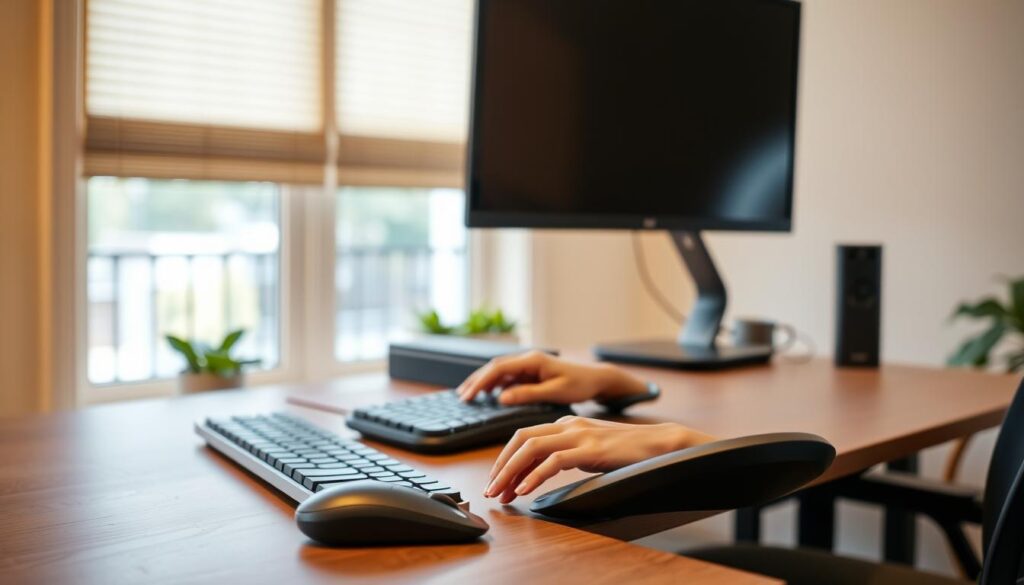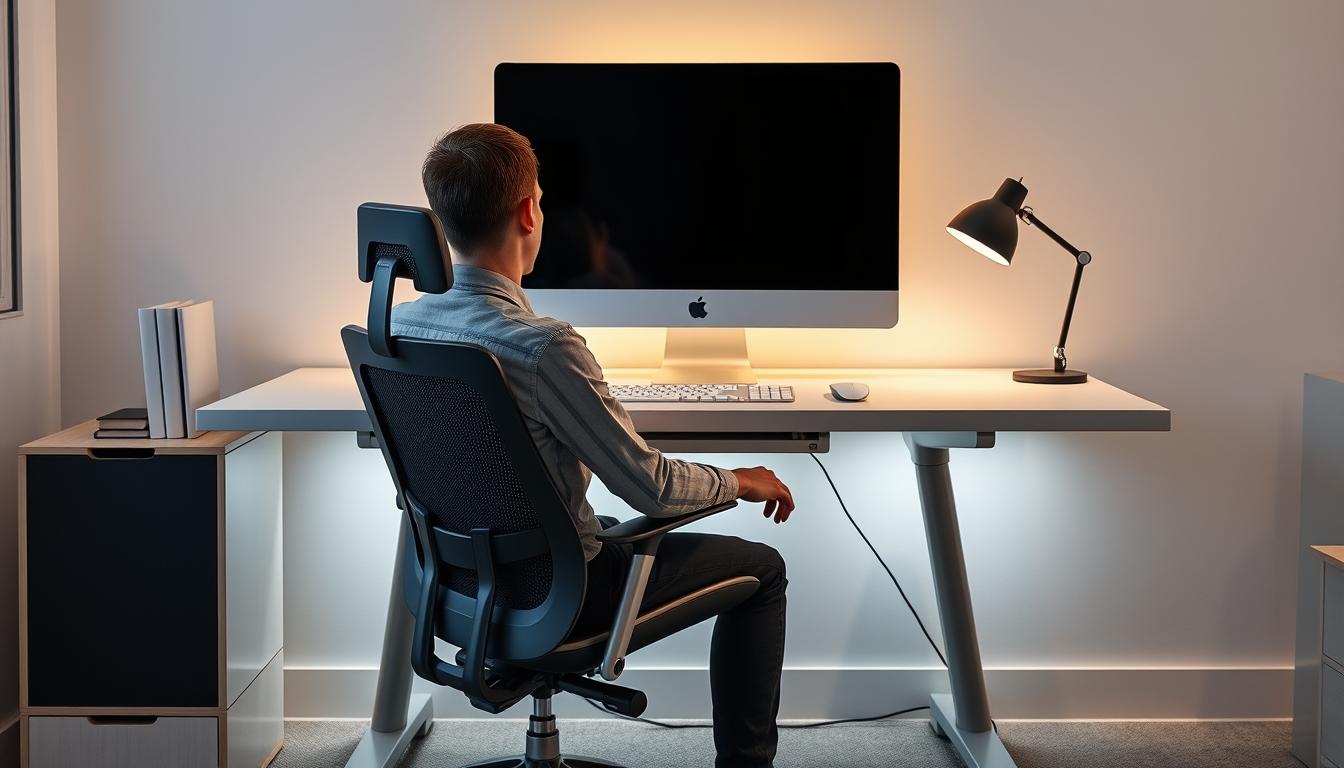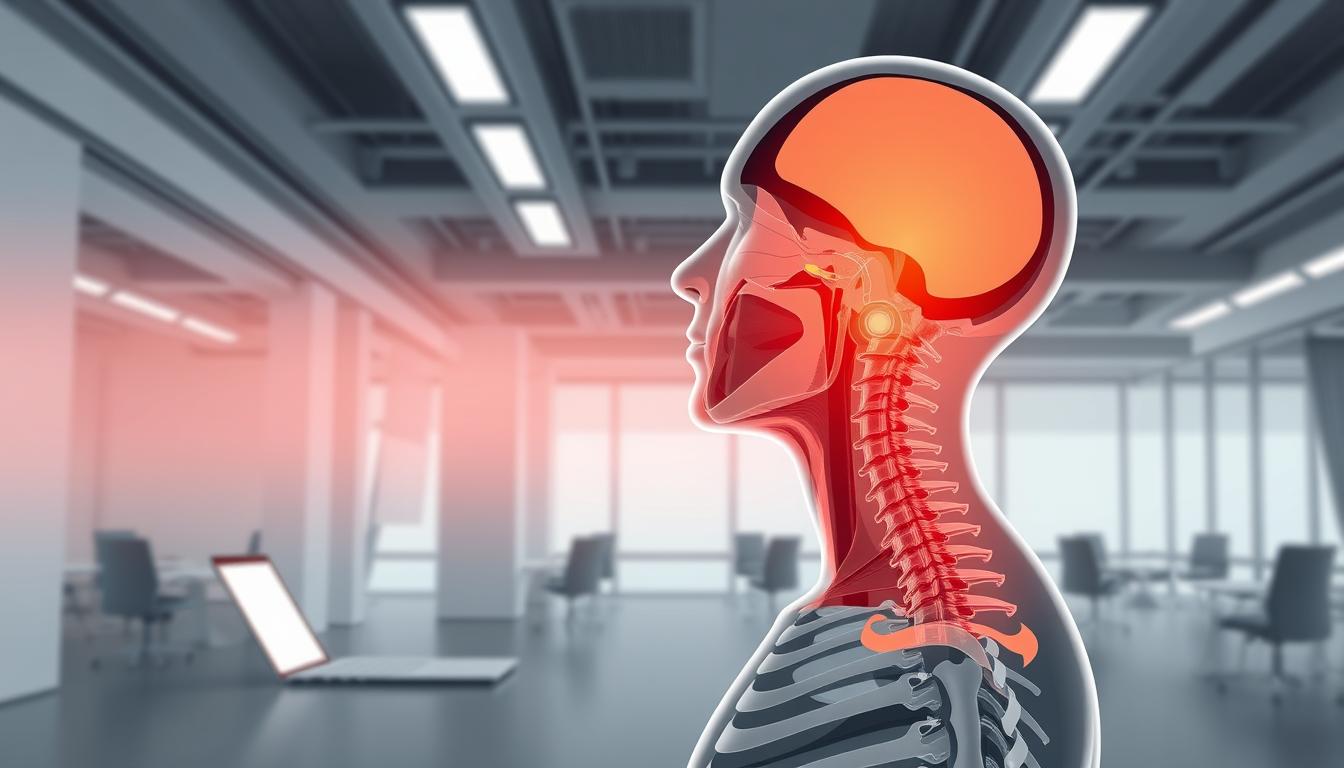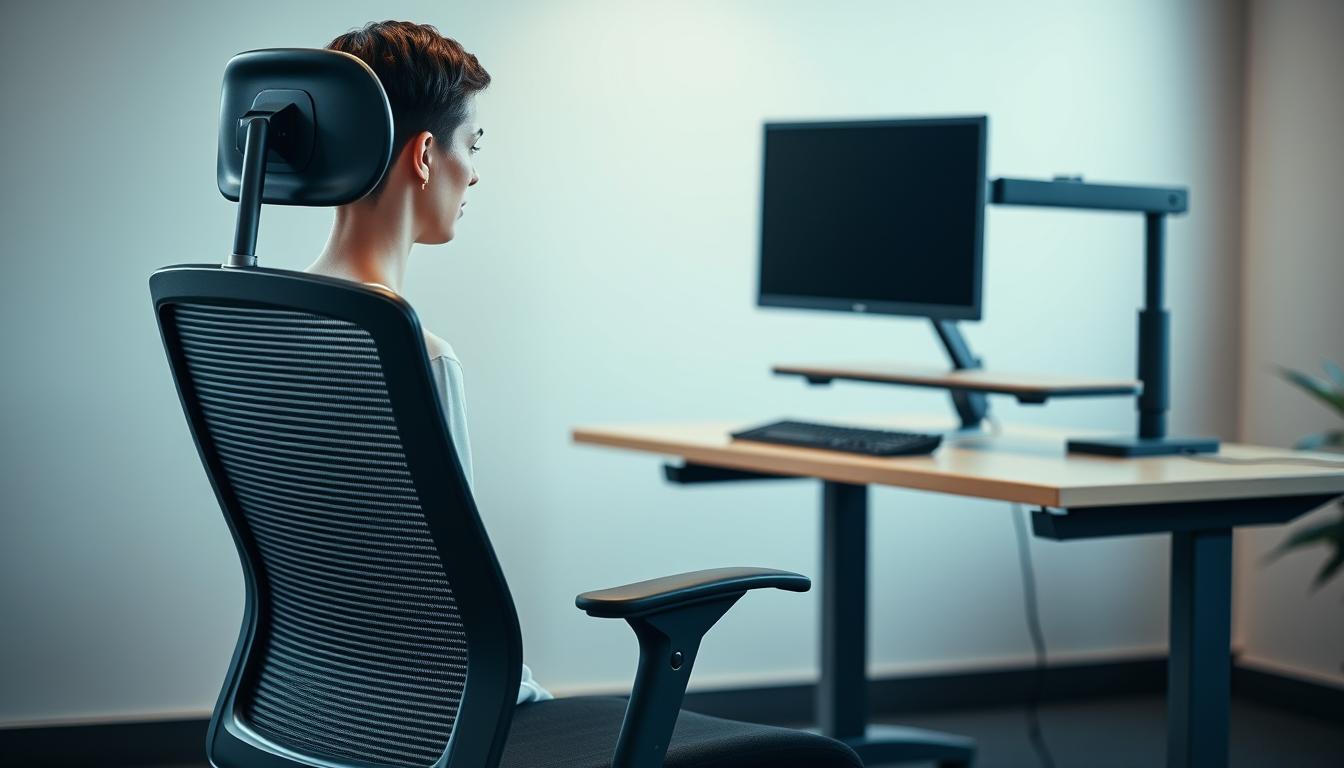Nowadays, many of us spend a lot of time in front of screens. It’s important to set up our monitors right to keep our necks healthy. Doing this makes working more comfortable and helps keep our posture right.
With the right monitor position, we can avoid neck strain. This prevents bigger problems with our muscles and bones later on. Let’s learn how to adjust our work area for better neck position and comfort.
Understanding the Importance of Good Posture
Good posture is key for your overall physical health, especially for your neck and back. Having an ergonomic workspace helps put your body in the right position. This reduces the chance of feeling discomfort or pain. People with desk jobs often face posture problems without proper ergonomics. These issues can lead to neck pain and strain.
The Impact of Ergonomics on Neck Health
Ergonomics is all about creating spaces that fit your body’s natural posture. When done right, you feel the perks of good posture like less neck pain and more get-up-and-go. Setting up your desk the ergonomic way makes sure everything matches up with how your body naturally moves. This way, you avoid the usual aches from sitting at a desk too long.
Common Posture Problems in Desk Jobs
Many workers struggle with posture because they sit too much and their desks aren’t set up properly. Let’s look at some common issues:
- Slouching, which leads to tired muscles.
- Stretching the neck out to see screens, causing strain.
- Chairs not set at the right height.
It’s really important to tackle these problems. Studies show keeping a good posture helps avoid the chronic pain and tiredness desk jobs often bring.
What is Proper Neck Alignment?
Understanding proper neck alignment helps keep you healthy and reduces discomfort. It means keeping your head and neck balanced. This cuts down on muscle strain and protects your spine. We’ll look at how the neck and head’s structure on your health. Your neck has vertebrae, muscles, and sensitive nerves. They all matter for a good posture and movement. Knowing about these parts helps you stand better and teaches you healthy habits.
The Anatomy of the Neck and Head
The neck has seven cervical vertebrae that are key for alignment. These bones work with muscles to help us move and keep up strong. Important muscles include the trapezius and sternocleidomastoid. Learning about this helps you see how bad posture can cause pain. It shows why we need to keep our cervical spine’s natural shape.
The Role of Neutral Spine Position in Posture
A neutral spine is crucial for correct neck placement. It keeps the spine’s natural curves, which stabilizes and supports our bodies. This stance spreads the weight evenly, easing pressure on certain spots. Highlighting the importance of a neutral spine is a key part of learning about posture. It encourages people to form habits that help their neck and spine in the long run.
How to Adjust Your Monitor for Proper Neck Alignment
Adjusting your monitor right can make sitting at your desk more comfy. It helps keep your neck aligned and lowers eye strain. Getting the height and distance of your monitor spot-on can stop neck pain.
Find the Optimal Height for Your Monitor
Having your monitor at the best height keeps your head straight. The top should be just a bit lower than your eyes, around 2 to 3 inches. This avoids you having to tilt your head too much. If you use bifocals, consider a monitor stand for the perfect angle.
Distance: How Far Should Your Monitor be?
The right distance for your monitor is crucial too. It should be about as far as your arm can reach, or 20 to 40 inches away. This range is easy on your eyes. And, it helps keep you from getting tired when you’re working a lot.
Choosing the Right Chair for Good Posture
Choosing a chair that helps you sit right is very important for people sitting at desks a lot. Look for an ergonomic chair because it has special features to keep your sitting posture healthy. Make sure the chair can be adjusted to fit your comfort level and supports your posture.
Characteristics of an Ergonomic Chair
An ergonomic chair should make you feel comfortable and supported. It should have:
- Adjustable height for different body sizes and desk heights.
- Lumbar support that follows the spine’s natural curve.
- Adjustable armrests to ease shoulder and neck stress.
- Seat adjustments for better leg placement.
How Chair Height Affects Posture
The height of your chair is key for a good sitting position. The right height means your feet can stay flat on the ground, giving you stability. This helps with the angle of your arms while typing and improves comfort. It also lowers the chance of having discomfort in your muscles and bones.
Setting Up Your Desk for Maximum Comfort
Getting your desk setup just right is key for comfort while working. You need your desk at the perfect height for good posture. It helps keep your shoulders relaxed and arms right by your side. This makes you more focused and healthier, even if you sit for hours.
The Importance of Desk Height
The perfect desk height keeps you from straining your back and neck. Keep these in mind:
- Maintain a 90-degree angle at the elbows when typing.
- Ensure enough space under the desk for leg movement without obstruction.
- Avoid sitting at a height that forces you to hunch over.
Keeping your workspace tidy is crucial for a good work environment. For better focus and comfort, here are some tips:
- Keep frequently used items within arm’s reach to minimize strain.
- Use organizers to prevent clutter and maintain a clean desk setup.
- Avoid blockages beneath the desk, which can hinder movement and lead to discomfort.
Positioning Your Keyboard and Mouse
Getting your keyboard and mouse right is key to staying comfortable. This is super important if you use a computer a lot. It helps avoid pain and injuries, making your desk a healthier place to work.
Best Practices for Keyboard Placement
Setting up your keyboard properly helps keep your wrists happy. Here are some tips:
- Adjust the keyboard height so your forearms are parallel to the floor.
- Ensure the wrists remain straight and not bent upwards or downwards.
- Keep the keyboard within easy reach to avoid overextending while typing.
Mouse Positioning to Reduce Strain
Your mouse setup is just as crucial as the keyboard. To keep your arm and wrist feeling good, follow these steps:
- Position the mouse at the same level as the keyboard.
- Keep the mouse close to the keyboard to prevent excessive reaching.
- Maintain a neutral arm position, using the larger muscles in the arm instead of straining the wrist.

Adjusting Your Monitor for Multiple Screens
Using several monitors, their setup greatly affects your posture and neck strain. The right monitor arrangement boosts comfort and work efficiency. It ensures you move your head less, making it easy to look from one screen to another without pain.
Positioning Primary and Secondary Monitors
Place the main monitor right in front of you, at eye level. This helps you look straight ahead, keeping your neck comfy. Put secondary monitors to the side, angled a bit towards you. You can then glance at them quickly, without turning your head too much.
Reducing Head Movement Between Screens
To cut down on how much you turn your head, adjust your chair’s height and how far you are from the screens. Make sure all monitors are easy to see without having to stretch. By making these ergonomic changes, you work healthier and get more done.
Incorporating Movement into Your Work Routine
Adding movement to your day can make you more comfortable and productive. Taking regular breaks is key to beat tiredness from sitting too long. Short breaks help ease neck pain and make you feel better over time.
Doing simple exercises at your desk can help you wake up and sit straighter.
The Benefits of Regular Breaks
Taking breaks often refreshes you. It cuts down on the stiffness from sitting for too long. Making time for movement improves blood flow, sharpens your focus, and makes you happier with your job.
Try to take a short break every 30 to 60 minutes. This could mean walking away from your desk or doing some light physical activity.
Simple Desk Exercises for Neck Relief
Adding exercises at your desk can ease neck pain right away. Here are some easy moves:
- Shoulder rolls: Lift your shoulders towards your ears, then roll them back and down to release tension.
- Neck stretches: Gently tilt your head towards one shoulder, hold for a few seconds, then switch sides.
- Seated twists: While sitting, rotate your torso to look over your shoulder, holding onto your chair for support.
These exercises fight the effects of sitting for too long. They also help you to have better posture and feel better at your desk.
Utilizing Technology for Better Ergonomics
Adding new ergonomic technology to workspaces helps make things more comfortable and healthy. Items like monitor stands and flexible desks improve how you sit and move. These tools help workers stay active without injury risks.
Monitor Stands and Adjustable Desks
Using monitor stands helps get your screen to the right height, cutting down on neck strain. An adjustable desk also helps by letting you switch between sitting and standing. This change promotes better blood flow and keeps you engaged.
Using Headsets for Phone Calls
Choosing headsets over regular phones can make a big difference in keeping your neck healthy. Headsets let you talk on calls without bending your neck. This easy change supports good posture and lessens neck pain.
Conclusion
Making your workspace ergonomic is key to better neck health and comfort at work. To do this, adjust your monitor, pick the right chair, and keep your desk tidy. These changes can cut down on strain and help you stay healthy over time.
Adding movement into your day helps with good posture and stops neck problems before they start. By setting up your workstation well and taking care of your health, you’ll feel better and work more efficiently.
Spending time and effort to make your work area better is smart. It keeps you comfortable now and healthy later. When you focus on ergonomics, your workdays become more productive and more enjoyable.



